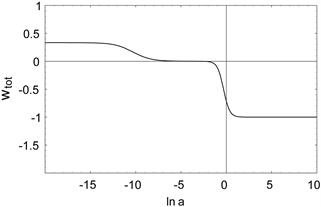Modern Physics
Vol.07 No.06(2017), Article ID:22803,7
pages
10.12677/MP.2017.76028
Evolution of the Universe in Scalar-Tensor Gravity
Xiaofei Zhang
Institute of Aeronautical Engineering, Binzhou University, Binzhou Shandong

Received: Nov. 4th, 2017; accepted: Nov. 17th, 2017; published: Nov. 27th, 2017

ABSTRACT
In this paper, we aim to discuss the evolvement of the dark energy that is assumed to be in the Scalar-tensor gravity. We derive and analyze the characteristics of this kind of dark energy model which exceed the general relativity framework, and compare the difference between the Scalar-tensor dark energy models and the general dark energy models. At last, with the current observational constraints, we choose a special model from the Scalar-tensor models to get the numerical calculation, and obtain results which is difficult for the general single scalar field model in the general relativity framework.
Keywords:Dark Energy Model, The Equation of State
Scalar-Tensor引力下的宇宙演化
张晓菲
滨州学院,航空工程学院,山东 滨州
收稿日期:2017年11月4日;录用日期:2017年11月17日;发布日期:2017年11月27日

摘 要
本文研究的是Scalar-tensor引力理论中暗能量模型在宇宙不同时期的演化行为。我们对这种超出广义相对论框架的暗能量模型的特征进行了推导和分析,并比较了它和广义相对论框架下单标量场暗能量模型的差别。最后,我们在现有观测数据的限制下选取了其中的一类模型进行了数值计算,得到了在广义相对论框架下,普通的单标量场暗能量模型难以得到的物理图像。
关键词 :暗能量模型,状态方程

Copyright © 2017 by author and Hans Publishers Inc.
This work is licensed under the Creative Commons Attribution International License (CC BY).
http://creativecommons.org/licenses/by/4.0/


1. 引言
当前的观测数据,如超新星、宇宙微波背景(CMB)、大尺度结构(LSS)等,支持具有负压特征的暗能量的存在 [1] [2] [3] [4] [5] ,并且,伴随着辐射和物质在宇宙膨胀过程中的稀释,暗能量在今天成为了最主要的构成部分并主导了宇宙的演化,标量场是暗能量可能的候选者之一。目前的实验观测数据在某种意义上暗示了暗能量的状态方程参数w越过−1,或者小于−1的可能 [6] [7] [8] [9] [10] ,这是普通的单标量场模型难以实现的。因此,本文讨论了一种scalar-tensor引力下的暗能量模型,此类模型可以实现普通的单标量场暗能量模型不能实现的物理图像。
作为一种动力学场,暗能量可能会与引力产生非最小耦合作用 [11] [12] ,对引力的修改是实现暗能量打破宇宙学常数限制的可能途径之一。在文中,我们主要分析scalar-tensor模型的演化,并讨论它的状态方程参数w越过宇宙学常数限制的可能。
2. Scalar-Tensor暗能量模型的演化推导
当暗能量场 和引力发生非最小耦合时,拉氏量可写作 [13] :
(1)
为了得到标量场 的演化趋势,需要根据拉氏量推导出运动学方程:
(2)
这里的“'”代表对 求导。其中的Ricci标量R将在下文求出。
在一般的scalar-tensor模型中,作用量可写作
(3)
这里的
根据最小作用量原理
(4)
我们可以得到能动量方程
(5)
这里的 为物质和辐射的能动量张量。
根据上面的方程(5),我们可以得到R的表达式:
(6)
在方程(5)中, 表示暗能量的能动量张量:
(7)
为宇宙中所有组分的能动量张量,包括了所有可能的构成成分。
(8)
因此,总的有效能量密度和压强可定义为:
(9)
总的能量密度和压强都是由暗能量、辐射和物质,及它们的耦合项组成。
暗能量本身的能量密度和压强可写作:
(10)
根据能动量密度的公式(10),暗能量的状态方程参数w为:
(11)
3. 具体模型的数值分析
以上的推导是适用于一般的scalar-tensor暗能量模型的。当K = 1,F = 1时,就回到了广义相对论框架下,状态方程的参数w在−1到+1之间。scalar-tensor暗能量模型的形式有许多种,为了便于定量的分析,我们在下面的分析中选取最简单的一种Brans-Dicke模型。
因此, 。
根据方程(2) (6),标量场的演化行为可由以下方程决定:
(12)
在这种情况下,状态方程可简化为
(13)
这里的 。
为了便于分析,定义一个新的函数 。
当g大于0时,暗能量的状态方程参数w大于−1;而g小于0时,暗能量的状态方程参数w降到−1以下(只考虑能量密度大于0的情况)。
从方程(12)可以推出:
选择 ,可得,
为了简化问题,首先忽略辐射和物质在今天及将来的作用,只单独考虑暗能量。从上面的推导可以看出,要分析在暗能量的状态方程参数w的演化情况,需要参数的具体数值。当前的观测数据对 做出
了限制 [14] [15] [16] [17] [18] 。并且,由于物质和辐射所占的比例为:
需要使今天的 ,
所以选取了 。
然后,我们利用暗能量场的运动方程(12),做数值计算并得到结果如图1~5。辐射和物质所占比例随着宇宙膨胀而变化的情况见图1。
从图2中可以看出,在宇宙的早期,因为辐射和物质先后主导了宇宙的演化,暗能量场ϕ的能量密度占的比例太小,几乎不起作用。随着宇宙的膨胀,辐射和物质被稀释到了一定程度,暗能量场ϕ开始了它的演化,并体现在了总体图像上。
图3表明暗能量场ϕ对lna的导数从零开始,随着宇宙的膨胀开始变成大于零的数,这表示暗能量ϕ在经过了因为能量密度所占比例太小而影响可以忽略的过程后,随着占总体比例越来越大而体现出来动力学场的特征。最后,ϕ对lna的导数又回到了零,这暗示着暗能量在经历了一系列变化后,最终将以常数的形式存在下去。
图4表示的是所有的宇宙构成成分随着宇宙膨胀状态方程的变化。首先,辐射占主导地位,然后是物质,最后辐射和物质在宇宙的膨胀中被稀释,暗能量决定了宇宙的最后的形态。
从图5看出,暗能量的状态方程参数w会有一系列复杂的变化行为,并在这个过程中穿越宇宙学常

Figure 1. as a function of lna
图1. 物质和辐射所占的比例随着lna的变化

Figure 2. as a function of lna
图2. 随着lna的演化

Figure 3. as a function of lna
图3. 随着lna的变化

Figure 4. wtot as a function of lna
图4. 所有组分的状态方程随着lna的演化

Figure 5. w-(de) as a function of lna
图5. 暗能量的状态方程随lna的演化
数−1的限制。在与之将图4对比后发现,在暗能量有着奇异的变化时,由于辐射和物质占主导地位,暗能量的复杂行为在总体演化中并没有体现出来。而当暗能量成为主要成分时,它已经表现为宇宙学常数。
4. 结论
综上所述,在scalar-tensor模型作为暗能量候选者的时候,以brans-dicke为例,在早期,宇宙的演化先后由辐射和物质决定,这个时候,暗能量场的能量密度可以忽略。随着宇宙的膨胀,辐射和物质先后衰减,暗能量开始了它的演化并成了主要构成部分。在经历了如震荡,状态方程参数w越过−1等一系列复杂的演化过程之后,暗能量以宇宙学常数的形式一直持续下去。
致谢
国家自然科学基金(No. 41401384, No. 41201368)。山东省科技发展基金项目(No. J14LJ02),滨州学院研究基金项目(No. 2013Y09)。
文章引用
张晓菲. Scalar-Tensor引力下的宇宙演化
Evolution of the Universe in Scalar-Tensor Gravity[J]. 现代物理, 2017, 07(06): 242-248. http://dx.doi.org/10.12677/MP.2017.76028
参考文献 (References)
- 1. Riess, A.G., et al. (1998) Observational Evidence from Supernovae for an Accelerating Universe and a Cosmological Constant. As-tronomical Journal, 116, 1009-1038. https://doi.org/10.1086/300499
- 2. Perlmutter, S. et al. (1999) Measurements of Omega and Lambda from 42 High Redshift Supernovae. Astronomical Journal, 517, 565-586. https://doi.org/10.1086/307221
- 3. Tonry, J.L. et al. (2003) Cosmological Results from High-Z Supernovae. Astronomical Journal, 594, 1-24. https://doi.org/10.1086/376865
- 4. Riess, A.G. et al. (2004) Type Ia Supernova Discoveries at z > 1 from the Hubble Space Telescope: Evidence for Past Deceleration and Constraints on Dark Energy Evolution. Astronomical Journal, 607, 665-687. https://doi.org/10.1086/383612
- 5. Clocchiatti, A. et al. (2006) Hubble Space Telescope and Ground-Based Observations of Type Ia Supernovae at Redshift 0.5: Cosmological Implications. Astronomical Journal, 642, 1-21. https://doi.org/10.1086/498491
- 6. Feng, B. Wang, X. and Zhang, X. (2005) Dark Energy Constraints from the Cosmic Age and Supernova. Physical Letters B, 607, 35-41. https://doi.org/10.1016/j.physletb.2004.12.071
- 7. Zhao, G.B., Xia, J.Q., Li, H., et al. (2007) Probing for Dynamics of Dark Energy and Curvature of Universe with Latest Cosmological Observations. Physical Letters B, 648, 8-13.
- 8. Zhang, X. and Wu, F.Q. (2005) Constraints on Holographic Dark Energy from Type Ia supernova Observations. Physical Review D, 72, 043524-043540. https://doi.org/10.1103/PhysRevD.72.043524
- 9. Chang, Z., Wu, F. Q. and Zhang, X. (2006) Constraints on Holographic Dark Energy from X-Ray Gas Mass Fraction of Galaxy Clusters. Physical Review Letters, 633, 14-18. https://doi.org/10.1016/j.physletb.2005.10.095
- 10. Di Valentino, E. and Melchiorri, A. (2017) First Cosmological Constraints Combining Planck with the Recent Gravitational-Wave Standard Siren Measurement of the Hubble Constant.
- 11. Brans, C. and Dicke, R.H. (1961) Mach’s Principle and a Relativistic Theory of Gravitation. Physical Review, 124, 925-935. https://doi.org/10.1103/PhysRev.124.925
- 12. Hrycyna, O. and Szydlowsk, M. (2013) Dynamical Complexity of the Brans-Dicke Cosmology. Journal of Cosmology and Astroparticle Physics, 1312, 16-49. https://doi.org/10.1088/1475-7516/2013/12/016
- 13. Emanuele, B., et al. (2015) Testing General Relativity with Present and Future Astrophysical Observations. Classical and Quantum Gravity, 32, 243001-243179. https://doi.org/10.1088/0264-9381/32/24/243001
- 14. Li, J.X., Wu, F.Q., Li, Y.C., et al. (2014) Cosmological constraint on Brans-Dicke Model. Research in Astronomy and Astrophysics, 15, 2151-2163.
- 15. Avilez, A. and Skordis, C. (2014) Cosmological Constraints on Brans-Dicke Theory. Physical Review Letters, 113, 011101-011105. https://doi.org/10.1103/PhysRevLett.113.011101
- 16. Ooba, J., Ichiki, K., Chiba, T., et al. (2017) Cosmological Constraints on Scalar-Tensor Gravity and the Variation of the Gravitational Constant. Progress of Theoretical and Experimental Physics, 4, 043E03-043E18. https://doi.org/10.1093/ptep/ptx046
- 17. Hrycyna, O., Szydlowski, M. and Kamionka, M. (2014) Dynamics and Cosmological Constraints on Brans-Dicke Cosmology. Physical Review D, 90, 124040-124052. https://doi.org/10.1103/PhysRevD.90.124040
- 18. Berti, E., Barausse, E., Cardoso, V. et al. (2015) Testing General Relativity with Present and Future Astrophysical Observations. Classical and Quantum Gravity, 32, 243001-243179. https://doi.org/10.1088/0264-9381/32/24/243001